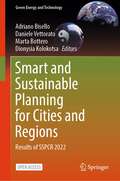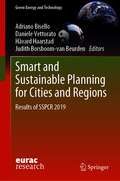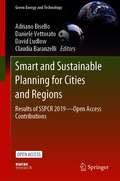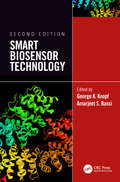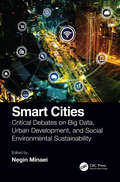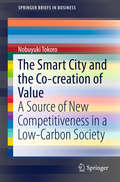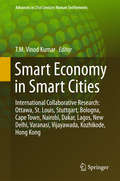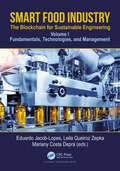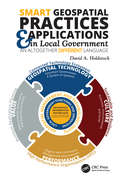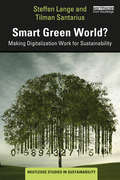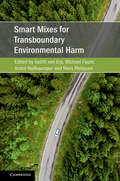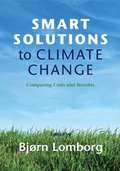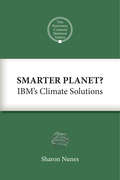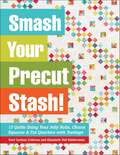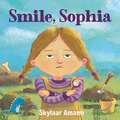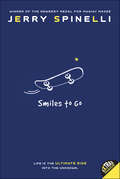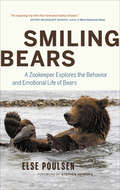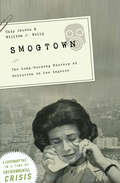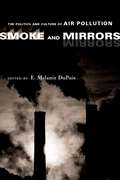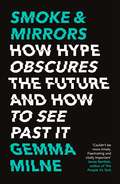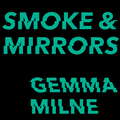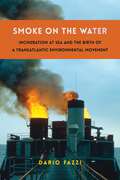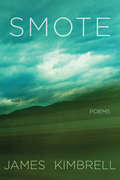- Table View
- List View
Smart and Sustainable Planning for Cities and Regions: Results of SSPCR 2022 (Green Energy and Technology)
by Adriano Bisello Daniele Vettorato Marta Bottero Dionysia KolokotsaThis open access book includes a selection of innovative contributions presented at the 4th international conference “Smart and Sustainable Planning for Cities and Regions 2022”, held in Bolzano, Italy in July 2022. Featuring 10 papers by academics and consultants, strongly rooted in practical experiences and international projects, it discusses current ground-breaking research in innovative and sustainable planning for cities, with a focus on the environmental, economic, and social challenges associated with the global sustainability transition and energy systems integration. The contributions are illustrative of the richness of the issues discussed and the breadth of the emerging themes, including innovative business models for building and infrastructure at district level, integrated sustainability assessment schemes for Positive Energy Districts, a material flow accounting model for regional metabolism, energy communities as a lever to promote historical and landscape values, optimized and electrified last-mile logistics, multi-criteria decision analysis tools to redefine center/periphery relationships, a framework for socio-spatial analysis related to social practices, design principles and communication technologies improving both indoor and outdoor public spaces, augmented nature-based solution coupling the green elements with the latest technologies to deliver healthier and more appealing cities.
Smart and Sustainable Planning for Cities and Regions: Results of SSPCR 2019 (Green Energy and Technology)
by Adriano Bisello Daniele Vettorato Håvard Haarstad Judith Borsboom-van BeurdenThis book offers a selection of research papers and case studies presented at the 3rd international conference “Smart and Sustainable Planning for Cities and Regions”, held in December 2019 in Bolzano, Italy, and explores the concept of smart and sustainable planning, including top contributions from academics, policy makers, consultants and other professionals. Innovation processes such as co-design and co-creation help establish collaborations that engage with stakeholders in a trustworthy and transparent environment while answering the need for new value propositions. The importance of an integrated, holistic approach is widely recognized to break down silos in local government, in particular, when aimed at achieving a better integration of climate-energy planning. Despite the ongoing urbanization and polarization processes, new synergies between urban and rural areas emerge, linking development opportunities to intrinsic cultural, natural and man-made landscape values. The increasing availability of big, real-time urban data and advanced ICT facilitates frequent assessment and continuous monitoring of performances, while allowing fine-tuning as needed. This is valid not only for individual projects but also on a wider scale. In addition, and circling back to the first point, (big) urban data and ICT can be of enormous help in facilitating engagement and co-creation by raising awareness and by providing insight into the local consequences of specific plans. However, this potential is not yet fully exploited in standard processes and procedures, which can therefore lack the agility and flexibility to keep up with the pulse of the city and dynamics of society. The book provides a multi-disciplinary outlook based on experience to orient the reader in the giant galaxy of smart and sustainable planning, support the transposition of research into practice, scale up visionary approaches and design groundbreaking planning policies and tools.
Smart and Sustainable Planning for Cities and Regions: Results of SSPCR 2019—Open Access Contributions (Green Energy and Technology)
by Adriano Bisello Daniele Vettorato David Ludlow Claudia BaranzelliThis open access book offers a selection of research papers and case studies presented at the 3rd international conference “Smart and Sustainable Planning for Cities and Regions”, held in December 2019 in Bolzano, Italy, and explores the concept of smart and sustainable planning, including top contributions from academics, policy makers, consultants and other professionals. Innovation processes such as co-design and co-creation help establish collaborations that engage with stakeholders in a trustworthy and transparent environment while answering the need for new value propositions. The importance of an integrated, holistic approach is widely recognized to break down silos in local government, in particular, when aimed at achieving a better integration of climate-energy planning. Despite the ongoing urbanization and polarization processes, new synergies between urban and rural areas emerge, linking development opportunities to intrinsic cultural, natural and man-made landscape values. The increasing availability of big, real-time urban data and advanced ICT facilitates frequent assessment and continuous monitoring of performances, while allowing fine-tuning as needed. This is valid not only for individual projects but also on a wider scale. In addition, and circling back to the first point, (big) urban data and ICT can be of enormous help in facilitating engagement and co-creation by raising awareness and by providing insight into the local consequences of specific plans. However, this potential is not yet fully exploited in standard processes and procedures, which can therefore lack the agility and flexibility to keep up with the pulse of the city and dynamics of society. The book provides a multi-disciplinary outlook based on experience to orient the reader in the giant galaxy of smart and sustainable planning, support the transposition of research into practice, scale up visionary approaches and design groundbreaking planning policies and tools.
Smart Biosensor Technology
by George K. Knopf Amarjeet S. BassiBased on the success of the first edition, this second edition continues to build upon fundamental principles of biosensor design and incorporates recent advances in intelligent materials and novel fabrication techniques for a broad range of real world applications. The book provides a multi-disciplinary focus to capture the ever-expanding field of biosensors. Smart Biosensor Technology, Second Edition includes contributions from leading specialists in a wide variety of fields with a common focus on smart biosensor design. With 21 chapters organized in five parts, this compendium covers the fundamentals of smart biosensor technology, important issues related to material design and selection, principles of biosensor design and fabrication, advances in bioelectronics, and a look at specific applications related to pathogen detection, toxicity monitoring, microfluidics and healthcare. Features Provides a solid background in the underlying principles of biosensor design and breakthrough technologies for creating more intelligent biosensors Focusses on material design and selection including cutting-edge developments in carbon nanotubes, polymer nanowires, and porous silicon Examines machine learning and introduces concepts such as DNA-based molecular computing for smart biosensor function Explores the principles of bioelectronics and nerve cell microelectrode arrays for creating novel transducers and physiological biosensors Devotes several chapters to biosensors developed to detect and monitor a variety of toxins and pathogens Offers expert opinions on the future directions, challenges and opportunities in the field
Smart Cities: Critical Debates on Big Data, Urban Development and Social Environmental Sustainability
by Negin MinaeiIn the age of global climate change, society will require cities that are environmentally self-sufficient, able to withstand various environmental problems and recover quickly. It is interesting to note that many "smart" solutions for cities are leading to an unsustainable future, including further electrification, an increased dependence on the Internet, Internet of Things, Big Data, and Artificial Intelligence, and basically any technology that leads us to consume more electricity. This book examines critical topics in Smart Cities such as true sustainability and the resilience required for all cities. It explores sustainability issues in agriculture and the role of agri-technology for a sustainable future, including a city’s ability to locally produce food for its residents. Features: Discusses safety, security, data management, and privacy issues in Smart Cities Examines the various emerging forms of transportation infrastructure and new vehicle technology Considers how energy efficiency can be achieved through behavioral change through specific building operations Smart Cities: Critical Debates on Big Data, Urban Development and Social Environmental Sustainability brings awareness to professionals working in the fields of environmental, civil, and transportation engineering, urban planners, and political leaders about different environmental aspects of Smart Cities and refocuses attention on critical urban infrastructure that will be necessary to respond to future challenges including climate change, food insecurity, natural hazards, energy production, and resilience.
The Smart City and the Co-creation of Value
by Nobuyuki TokoroThe original point that differentiates this text from otherwise similar texts is that it looks at the building of smart cities from the viewpoint of an interchange of knowledge among companies in different industries, or "Ba" as shared context in motion, and emphasizes that the resulting value becomes a source of new corporate competitive advantage. In recent years numerous publications have appeared that analyze smart cities from various perspectives including urban planning and administration, network theory, and innovation. However, few are academic texts that approach the subject from the viewpoint of corporate competitive advantage against a theoretical background in management studies, as this one does. This book is the first full-scale academic work to analyze smart cities from the viewpoint of corporate competitive advantage. Research into corporate competitive advantage includes the positioning and the resource-based views, with the former focusing on companies' external environment and the latter on their internal resources. Although these theories' foci of attention necessarily differ, they both developed as tools for analyzing companies' relative merits and their chances of succeeding in the marketplace, and they take the common premise that competitive advantage is built through competition among companies. In contrast, this book sees corporate competitive advantage as arising not through competition but through "co-creation" among companies. It differs in its approach from existing theories in thinking that emphasizing co-creation over competition enables an analysis that better describes actual conditions when considering smart cities and corporate competitive advantage. Put another way, when new values arise from attempts to exchange and fuse knowledge, expertise, and other factors at the "ba" where companies from different industries collaborate, these values are surely brought about through co-creation among companies. Another point regarding this book's original perspective on competitive advantage is its emphasis on the relationship between the creation of social value and competitive advantage. The question of the extent to which socially useful values can be created in the markets of the 21st century is closely linked to corporate competitive advantage. The issues of building smart cities and corporate competitive advantage are themes that this perspective can firmly grasp. This book intends to take up three different projects from among the smart-city building developments taking shape in Japan, and undertake case studies based on the theoretical framework outlined above. The central themes will analyze the mechanism of co-creation among companies and the relationship of created value to competitive advantage. This analysis aims to demonstrate one model relating to corporate competitive advantage in the 21st century.
Smart Economy in Smart Cities
by T. M. Vinod KumarThe present book highlights studies that show how smart cities promote urban economic development. The book surveys the state of the art of Smart City Economic Development through a literature survey. The book uses 13 in depth city research case studies in 10 countries such as the North America, Europe, Africa and Asia to explain how a smart economy changes the urban spatial system and vice versa. This book focuses on exploratory city studies in different countries, which investigate how urban spatial systems adapt to the specific needs of smart urban economy. The theory of smart city economic development is not yet entirely understood and applied in metropolitan regional plans. Smart urban economies are largely the result of the influence of ICT applications on all aspects of urban economy, which in turn changes the land-use system. It points out that the dynamics of smart city GDP creation takes 'different paths,' which need further empirical study, hypothesis testing and mathematical modelling. Although there are hypotheses on how smart cities generate wealth and social benefits for nations, there are no significant empirical studies available on how they generate urban economic development through urban spatial adaptation. This book with 13 cities research studies is one attempt to fill in the gap in knowledge base.
Smart Food Industry: Fundamentals, Technologies, and Management, Volume 1
by Eduardo Jacob-Lopes Leila Queiroz Zepka Mariany Costa DepráSmart Food Industry: The Blockchain for Sustainable Engineering, Volume I - Fundamentals, Technologies, and Management is a comprehensive overview of the current state of knowledge about food engineering and processing, under sustainable engineering perspective. This book includes disruptive approaches that will potentially enable the food industry for the transition to sustainable production. Divided into four parts, the book explores (i) fundamentals of sustainable food, (ii) conventional technologies in the food industry, (iii) sustainabile emerging technologies in food industries, and (iv) sustainable management in food industries. The book is an invaluable reference resource for students, researchers, graduates, and professionals, in general, who wish to gain knowledge in the engineering and food processing area as well as about sustainable food industry practices.
Smart Geospatial Practices and Applications in Local Government: An Altogether Different Language
by David A. HoldstockThe demand on local government to do more with less by improving operations, increasing productivity, and making better and more informed decisions increases constantly. On a departmental level Geographic Information Systems are helping meet this demand but the majority of local government organizations do not take the time to understand the GIS needs and opportunities of each and every department. This book: Discusses how towns, cities and counties and their specific departments should actually use GIS Explains the best ways to use GIS tools through many specific case studies and step by step instructions Emphasises local government needs first before offering solutions Gives readers a practical and understandable way of thinking about managing and making GIS successful This book is the guide that details best GIS applications and practices for the 34 departments in local government that can, and should, use GIS technology. It explains in details how, why, and what each department should implement, a clear and understandable explanation of departmental GIS.
Smart Green World?: Making Digitalization Work for Sustainability (Routledge Studies in Sustainability)
by Steffen Lange Tilman SantariusIn this book, Steffen Lange and Tilman Santarius investigate how digitalization influences environmental and social sustainability. The information revolution is currently changing the daily lives of billions of people worldwide. At the same time, the current economic model and consumerist lifestyle needs to be radically transformed if society is to overcome the challenges humanity is facing on a finite planet. Can the much-discussed disruption potential of digitalization be harnessed for this purpose? Smart Green World? provides guiding principles for a sustainable digital society and develops numerous hands-on proposals for how digitalization can be shaped to become a driving force for social transformation. For instance, the authors explain why more digitalization is needed to realize the transition towards 100% renewable energy and show how this can be achieved without sacrificing privacy. They analyze how the information revolution can transform consumption patterns, mobility habits and industry structures – instead of fostering the consumption of unneeded stuff due to personalized commercials and the acceleration of life. The authors reveal how Artificial Intelligence and the Industrial Internet of Things pose novel environmental challenges and contribute to a polarization of income; but they also demonstrate how the internet can be restored to its status as a commons, with users taking priority and society at large reaping the benefits of technological change in a most democratic way. Providing a comprehensive and practical assessment of both social and environmental opportunities and challenges of digitalization, Smart Green World? Making Digitalization Work for Sustainability will be of great interest to all those studying the complex interrelationship of the twenty-first-century megatrends of digitalization and decarbonization.
Smart Mixes for Transboundary Environmental Harm (Cambridge Studies on Environment, Energy and Natural Resources Governance)
by Judith Van Erp Michael Faure André Nollkaemper Niels PhilipsenThis work offers a multidisciplinary approach to legal and policy instruments used to prevent and remedy global environmental challenges. It provides a theoretical overview of a variety of instruments, making distinctions between levels of governance (treaties, domestic law), types of instruments (market-based instruments, regulation, and liability rules), and between government regulation and private or self-regulation. The book's central focus is an examination of the use of mixes between different types of regulatory and policy instruments and different levels of governance, notably in climate change, marine oil pollution, forestry, and fisheries. The authors examine how, in practice, mixes of instruments have often been developed. This book should be read by anyone interested in understanding how interactions between different instruments affect the protection of environmental resources.
Smart Solutions to Climate Change: Comparing Costs and Benefits
by Bjørn LomborgThe failure of the Copenhagen climate conference in December 2009 revealed major flaws in the way the world's policy makers have attempted to prevent dangerous levels of increases in global temperatures. The expert authors in this specially commissioned collection focus on the likely costs and benefits of a very wide range of policy options, including geo-engineering, mitigation of CO2, methane and 'black carbon', expanding forest, research and development of low-carbon energy and encouraging green technology transfer. For each policy, authors outline all of the costs, benefits and likely outcomes, in fully referenced, clearly presented chapters accompanied by shorter, critical alternative perspectives. To further stimulate debate, a panel of economists, including three Nobel laureates, evaluate and rank the attractiveness of the policies. This authoritative and thought-provoking book will challenge readers to form their own conclusions about the best ways to respond to global warming.
Smarter Planet?: IBM's Climate Solutions
by Sharon Nunes Eban GoodsteinOn October 19, 2011, Sharon Nunes participated in The National Climate Seminar, a series of webinars sponsored by Bard College's Center for Environmental Policy. The online seminars provide a forum for leading scientists, writers, and other experts to talk about critical issues regarding climate change. The series also opens a public conversation, inviting participants to ask questions and contribute their own thoughts. Sharon Nunes is Vice President of the Smarter Cities Strategy & Solutions program at IBM, working with municipal leaders to manage urban systems more efficiently. In her lecture, Nunes discussed the ability of smart grids and other information technology to save energy, time, and costs. Questions focused on the barriers to implementing these systems, and Nunes addressed ongoing challenges as well as successful programs. This E-ssential is an edited version of Nunes' talk and the subsequent question and answer session. While some material has been cut and some language modified for clarity, the intention was to retain the substance of the original discussion.
Smash Your Precut Stash!: 13 Quilts Using Your Jelly Rolls, Charm Squares & Fat Quarters with Yardage
by Kate Carlson Colleran Elizabeth Veit BalderramaNever let your favorite precuts go to waste again Have you ever bought the perfect stack of fat quarters, only to see that same bundle decorating your shelf two years later? Give stashed fabrics new life with 13 quilt patterns to make the most of your precut collection! Kate Carlson Colleran and Elizabeth Veit Balderrama, both of Seams Like a Dream Quilt Designs, show you the basics of how to quilt from your stash, with a special focus on color, print, and scale. More than a dozen vibrant and versatile quilt patterns are tailored to precut fabric strips, squares, and fat quarters. Learn how to add additional yardage, mix and match different fabric lines, and design a stunning quilt from fabric you already have on hand. 13 fresh patterns to use your stash of precut squares, strips, and fat quarters Options galore! Alternate colorways and precut choices, such as using 3 fat quarters, 11 precut strips, or 42 charm squares Tips for resizing quilts with multiple borders or border blocks
Smile, Sophia
by Skylaar AmannIn Smile, Sophia, a smart, relatable picture book by author/illustrator Skylaar Amann, a serious dino-loving little girl just doesn't feel like smiling...and that's okay.Sophia loves finding fossils and digging up dinosaur bones. But she doesn’t love the way all the grownups just want her to smile. What does smiling have to do with the very serious business of being a scientist?! She’ll smile when she has something to smile about! In this picture book by Skylaar Amann, a young girl shows that being strong, and smart, and really good at what she does is more than enough—and if she smiles, it’s because she wants to!
Smiles to Go
by Jerry SpinelliWhat is stargazer, skateboarder, chess champ, pepperoni pizza eater, older brother, sister hater, best friend, first kisser, science geek, control freak Will Tuppence so afraid of in this great big universe?Jerry Spinelli knows.
Smiling Bears: A Zookeeper Explores the Behavior and Emotional Life of Bears
by Else PoulsenAn award-winning zookeeper, author, and bear expert shares the insights she has gleaned from a career spent working with the majestic animals. Few people have known bears as intimately as Else Poulsen has. This remarkable book reveals the many insights about bears and their emotional lives that she has gained through her years of work with them. Always approaching each bear with the same two questions in mind—&“Who are you?&” and &“What can I do for you?&” —Poulsen has shared in the joy of a polar bear discovering soil under her paws for the first time in 20 years and felt the pride of a cub learning to crack nuts with her molars. She has also felt the hateful stare of one bear that she could not befriend, and she has grieved in the abject horror of captivity for a sun bear in Indonesia. Featuring photographs from Poulsen&’s personal collection, Smiling Bears provides an enlightening and moving portrait of bears in all their richness and complexity.Praise for Smiling Bears &“An inspiring trip into the mind and reality of bears.&” —Jeffrey Moussaieff Masson, author of When Elephants Weep &“If you doubt bears are able to smile, buy this book—it&’ll open your eyes and change the view.&” —Terry D. Debruyn, author of Walking with Bears &“A rare window of opportunity to begin to understand not only the incredible challenges that face these species but also the meaning of their existence in nature.&” —Robert Buchanan, president of Polar Bears International
Smith & Wesson Hand Guns
by Roy C. McHenry Walter F. Roper“The story of Smith & Wesson handguns and their evolution is one of the hallowed tales of American firearms’ history,” according to the firearms writer Jim Casada. Anyone who collects Smith & Wessons or is simply interested in their backstory will cherish this book.Though originally published in 1945, more than half a century ago, Smith & Wesson Hand Guns remains the source for Smith & Wesson enthusiasts. It is an authoritative reference and has remained, for over five decades, the cornerstone upon which Smith & Wesson research rests. This work is foundational, supported by sixty-three detailed illustrations showing the handguns, the unique hammer mechanism, and facsimile reproductions of vintage advertising copy.The first twenty-four chapters of the book, which tell the story of Smith and Wesson and the development of Smith & Wesson handguns, are very informative. After the reader becomes familiar with Smith and Wesson’s history together, as well as their creation of a business, illustrations exhibiting Smith & Wesson handguns will show rather than tell of their magnificence. Finally, descriptions of different caliber guns are given, where readers will gain invaluable information regarding Smith & Wesson handguns. For any Smith & Wesson enthusiast or collector, this work is impossible to put down.
Smogtown: The Lung-Burning History of Pollution in Los Angeles
by Chip Jacobs William J. Kelly“A zany and provocative cultural history” of LA’s infamous air pollution and the struggle to combat it from the 1940s to today (Kirkus).The smog beast wafted into downtown Los Angeles on July 26, 1943. Nobody knew what it was. Secretaries rubbed their eyes. Traffic cops seemed to disappear in the mysterious haze. Were Japanese saboteurs responsible? A reckless factory? The truth was much worse—it came from within, from Southern California’s burgeoning car-addicted, suburban lifestyle. Smogtown is the story of pollution, progress, and how an optimistic people confronted the epic struggle against airborne poisons barraging their hometowns. There are scofflaws and dirty deals aplenty, plus murders, suicides, and an ever-present paranoia about mass disaster. California based journalists Chip Jacobs and William J. Kelly highlight the bold personalities involved, the corporate-tainted science, the terrifying health costs, the attempts at cleanup, and how the smog battle helped mold the modern-day culture of Los Angeles.
Smoke and Mirrors: The Politics and Culture of Air Pollution
by E. Melanie DuPuisWho gets to breathe clean air? Who benefits from the cheaper products produced with dirty air? The answers, as the contributors to Smoke and Mirrors tell us, are sometimes as gray as the air itself. From the coal factory chimneys in Manchester in the late nineteenth century to the smog hanging over Los Angeles in the late twentieth century, air pollution has long been one of the greatest threats to our environment. In this important collection of original essays, the leading environmental scientists and social scientists examine the politics of air pollution policies and help us to understand the ways these policies have led to, idiosyncratic, effective, ineffective, and even disastrous choices about what we choose to put into and take out of the air. Offering historical, contemporary and cross-national perspectives, this volume provides a refreshing new approach to understanding how air pollution policies have evolved over time.
Smoke & Mirrors: How Hype Obscures the Future and How to See Past It
by Gemma Milne'Stop following the news until you've read Gemma Milne's persuasive analysis of the hype and bullshit that distort our understanding of emerging science. As she shows, the starting point to grasping the genuine opportunities of AI, life sciences and climate tech is a healthy dose of critical thinking'David Rowan, founding editor of WIRED UK and author of Non-Bullshit Innovation: Radical Ideas from the World's Smartest Minds'Couldn't be more timely. Fascinating and vitally important'Jamie Bartlett, author of The People Vs Tech'A much-needed blast of fresh air! Gemma Milne expertly shows us how to separate the truth from the hype surrounding the emerging techs of today, and those of the near-tomorrow'Lewis Dartnell, author of Origins: How the Earth Made Us'I loved this book! This is exactly the sort of sceptical, cut-through-the crap-but-still-excited-about-what's-emerging book around tech innovation that's sorely needed, yet is so hard to find . . . essential reading for anyone who's serious about how real-world advances might be effectively harnessed to build a better future'Dr Andrew Maynard, scientist and author of Films from the Future and Future Rising'[A] vital contribution in a world where technological progress promises so much, but too often disappoints. If, like me, you believe that advances in science and technology are our best hope for solving the grand challenges of our times, this book is the indispensable guide to avoiding the mirages and the charlatans along the way'Matt Clifford, co-founder and CEO of Entrepreneur First'A refreshingly grown-up, clear-headed look at the interaction between science, technology and the media - readable without being dumbed down, acknowledging complexities without being heavy'Tom Chivers, author of The AI Does Not Hate You'ROBOTS WILL STEAL YOUR JOB!''AI WILL REVOLUTIONISE FARMING!''GENETIC EDITING WILL CURE CANCER!'Bombastic headlines about science and technology are nothing new. To cut through the constant stream of information and misinformation on social media, or grab the attention of investors, or convince governments to take notice, strident headlines or bold claims seem necessary to give complex, nuanced information some wow factor.But hype has a dark side, too.It can mislead. It can distract. It can blinker us from seeing what is actually going on.From AI, quantum computing and brain implants, to cancer drugs, future foods and fusion energy, science and technology journalist Gemma Milne reveals hype to be responsible for fundamentally misdirecting or even derailing crucial progress.Hype can be combated and discounted, though, if you're able to see exactly where, how and why it is being deployed.This book is your guide to doing just that.
Smoke & Mirrors: How Hype Obscures the Future and How to See Past It
by Gemma Milne'Stop following the news until you've read Gemma Milne's persuasive analysis of the hype and bullshit that distort our understanding of emerging science. As she shows, the starting point to grasping the genuine opportunities of AI, life sciences and climate tech is a healthy dose of critical thinking'David Rowan, founding editor of WIRED UK and author of Non-Bullshit Innovation: Radical Ideas from the World's Smartest Minds'Couldn't be more timely. Fascinating and vitally important'Jamie Bartlett, author of The People Vs Tech'A much-needed blast of fresh air! Gemma Milne expertly shows us how to separate the truth from the hype surrounding the emerging techs of today, and those of the near-tomorrow'Lewis Dartnell, author of Origins: How the Earth Made Us'I loved this book! This is exactly the sort of sceptical, cut-through-the crap-but-still-excited-about-what's-emerging book around tech innovation that's sorely needed, yet is so hard to find . . . essential reading for anyone who's serious about how real-world advances might be effectively harnessed to build a better future'Dr Andrew Maynard, scientist and author of Films from the Future and Future Rising'[A] vital contribution in a world where technological progress promises so much, but too often disappoints. If, like me, you believe that advances in science and technology are our best hope for solving the grand challenges of our times, this book is the indispensable guide to avoiding the mirages and the charlatans along the way'Matt Clifford, co-founder and CEO of Entrepreneur First'A refreshingly grown-up, clear-headed look at the interaction between science, technology and the media - readable without being dumbed down, acknowledging complexities without being heavy'Tom Chivers, author of The AI Does Not Hate You'ROBOTS WILL STEAL YOUR JOB!''AI WILL REVOLUTIONISE FARMING!''GENETIC EDITING WILL CURE CANCER!'Bombastic headlines about science and technology are nothing new. To cut through the constant stream of information and misinformation on social media, or grab the attention of investors, or convince governments to take notice, strident headlines or bold claims seem necessary to give complex, nuanced information some wow factor.But hype has a dark side, too.It can mislead. It can distract. It can blinker us from seeing what is actually going on.From AI, quantum computing and brain implants, to cancer drugs, future foods and fusion energy, science and technology journalist Gemma Milne reveals hype to be responsible for fundamentally misdirecting or even derailing crucial progress.Hype can be combated and discounted, though, if you're able to see exactly where, how and why it is being deployed.This book is your guide to doing just that.
Smoke & Mirrors: How Hype Obscures the Future and How to See Past It
by Gemma Milne'Stop following the news until you've read Gemma Milne's persuasive analysis of the hype and bullshit that distort our understanding of emerging science. As she shows, the starting point to grasping the genuine opportunities of AI, life sciences and climate tech is a healthy dose of critical thinking'David Rowan, founding editor of WIRED UK and author of Non-Bullshit Innovation: Radical Ideas from the World's Smartest Minds'Couldn't be more timely. Fascinating and vitally important'Jamie Bartlett, author of The People Vs Tech'A much-needed blast of fresh air! Gemma Milne expertly shows us how to separate the truth from the hype surrounding the emerging techs of today, and those of the near-tomorrow'Lewis Dartnell, author of Origins: How the Earth Made Us'I loved this book! This is exactly the sort of sceptical, cut-through-the crap-but-still-excited-about-what's-emerging book around tech innovation that's sorely needed, yet is so hard to find . . . essential reading for anyone who's serious about how real-world advances might be effectively harnessed to build a better future'Dr Andrew Maynard, scientist and author of Films from the Future and Future Rising'[A] vital contribution in a world where technological progress promises so much, but too often disappoints. If, like me, you believe that advances in science and technology are our best hope for solving the grand challenges of our times, this book is the indispensable guide to avoiding the mirages and the charlatans along the way'Matt Clifford, co-founder and CEO of Entrepreneur First'A refreshingly grown-up, clear-headed look at the interaction between science, technology and the media - readable without being dumbed down, acknowledging complexities without being heavy'Tom Chivers, author of The AI Does Not Hate You'ROBOTS WILL STEAL YOUR JOB!''AI WILL REVOLUTIONISE FARMING!''GENETIC EDITING WILL CURE CANCER!'Bombastic headlines about science and technology are nothing new. To cut through the constant stream of information and misinformation on social media, or grab the attention of investors, or convince governments to take notice, strident headlines or bold claims seem necessary to give complex, nuanced information some wow factor.But hype has a dark side, too.It can mislead. It can distract. It can blinker us from seeing what is actually going on.From AI, quantum computing and brain implants, to cancer drugs, future foods and fusion energy, science and technology journalist Gemma Milne reveals hype to be responsible for fundamentally misdirecting or even derailing crucial progress.Hype can be combated and discounted, though, if you're able to see exactly where, how and why it is being deployed.This book is your guide to doing just that.
Smoke on the Water: Incineration at Sea and the Birth of a Transatlantic Environmental Movement (Global America)
by Dario FazziThe U.S. government, military, and industry once saw ocean incineration as the safest and most efficient way to dispose of hazardous chemical waste. Beginning in the late 1960s, toxic chemicals such as PCBs and other harmful industrial byproducts were taken out to sea to be destroyed in specially designed ships equipped with high-temperature combustion chambers and smokestacks. But public outcry arose after the environmental and health risks of ocean incineration were exposed, and the practice was banned in the early 1990s.Smoke on the Water traces the rise and fall of ocean incineration, showing how a transnational environmental movement tested the limits of U.S. political and economic power. Dario Fazzi examines the anti-ocean-incineration movement that emerged on both sides of the Atlantic, arguing that it succeeded by merging local advocacy with international mobilization. He emphasizes the role played at the grassroots level by women, migrant workers, and other underrepresented groups who were at greatest risk. Environmental groups, for their part, gathered and shared evidence about the harms of at-sea incineration, building scientific consensus and influencing international debates.Smoke on the Water tells the compelling story of a campaign against environmental degradation in which people from marginalized communities took on the might of the U.S. military-industrial complex. It offers new insights into the transnational dimensions of environmental regulation, the significance of nonstate actors in international history, and the making of environmental justice movements.
Smote
by James Kimbrell"Smote is a book of the dark reality of our daily existence; it is a book of abiding grace."--Robert Olen ButlerI release you like the crank-addled truck driverreleases his cargo at the midnight dockuntil the warehouse is one in a trailof crumbs, little light left on behind him. James Kimbrell is the author of The Gatehouse Heaven and My Psychic, and the co-translator of Three Poets of Modern Korea. He been the recipient of the Discovery/The Nation Award, a Whiting Award, a fellowship from the NEA, and a Morton Prize.
